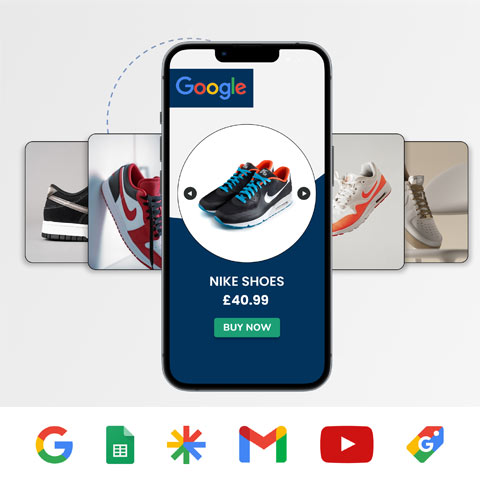App or Mobile Website? The million-dollar mobile question

The rise of mobile commerce has created many opportunities and challenges for businesses, but one questions remains very much unanswered, should you develop a dedicated mobile app or optimise your website for mobile? This whitepaper evaluates the pros and cons of apps vs mobile websites and provides best practice advice on how to develop the right strategy for your business. Download now to learn how to best integrate mobile into your overall commerce strategy.
Get the downloadBelow is an excerpt of "App or Mobile Website? The million-dollar mobile question". To get your free download, and unlimited access to the whole of bizibl.com, simply log in or join free. |

|
Smartphone adoption rates are growing at an astonishing rate. If you’re not thinking about how your organization should connect with customers via their mobile devices, you should be. Consider these statistics:
- At the beginning of 2011, U.S. smartphone adoption reached 27 percent of mobile subscribers, while European adoption reached 31 percent.
- 53 percent of smartphone users routinely browse the Web, and 72 percent of European-based iPhone users access the Internet daily.
- 82 percent of consumers have used their mobile phones while shopping in a brick-and-mortar establishment.
- 17 percent of consumers have shown an in-store sales associate a photo of a product on their mobile device.
- In 2015, $119bn worth of goods and services will be purchased via a mobile phone.
Organizations must include mobile in their commerce initiatives to drive sales. As consumers increasingly use their smartphones to browse the web and shop, they will expect an optimal experience – from the proper rendering of websites on their small device screens, to the ability to review products and make purchases. Smartphone usage is far more transient compared to desktop web usage. Smartphone users are away from their PC and are in busy situations (i.e. in a bar, on a bus or on a train) where they have less time to complete transactions. A B2C mobile funnel should be optimized accordingly, for example by implementing Facebook login and registration, as it reduces the time required to check out. Retailers who don’t provide these capabilities risk losing customers – and sales. environment.
However, rather than rush to react and implement a mobile commerce strategy, it’s critical to take a thoughtful, considered approach. This white paper offers guidance including:
- Important factors to consider before implementing a mobile commerce strategy
- The pros and cons of developing retail-based mobile applications.
- The advantages and disadvantages of optimizing websites for mobile devices.
- How to decide which mobile strategy is best for your organization.
Mobile device adoption is occurring quickly, presenting organizations with many opportunities to sell products and communicate with customers via the mobile touch point. It’s important to consider how best to take advantage of this form of customer interaction, in order to optimally present your brand.
Factors to Consider Before Implementing a Mobile Strategy
Organizations must develop a mobile strategy that truly fi ts their unique business and customers. Here is a list of factors and considerations to help shape your company’s approach:
[Download PDF for charts, graphs and tables - register now!]
These factors will help set the priorities for your mobile commerce strategy. Next, your organization must consider whether to focus efforts on enhancing its commerce website for use by mobile devices, or to develop specifi c mobile apps – or both. There is debate about which approach is best, however, everyone agrees that organizations, especially retailers, must take action.
The Benefits and Challenges of Website Optimization
Like any important decision, to help make the right one, start by weighing the pros and cons. And specifi cally, when it comes to choosing where to focus your mobile efforts, available resources and expertise will have big roles to play.
The advantages of optimized websites
The primary advantage of focusing on the optimization of websites for mobile devices is keeping customers engaged as they pass between channels. Sites that are not mobile-ready may confuse consumers with their lack of functionality, causing them to be less likely to convert an interest in a product to an actual purchase. Also, consider how individuals use their smartphones to fi nd sites. They often surf and use search engines to fi nd what they’re looking for. It’s much easier to drive advertising traffi c to a mobile website than to encourage customers to download an application. In addition, mobile websites offer mass appeal. They can be built for immediate accessibility, regardless of mobile device. One optimized website has broader reach to all devices, compared with one mobile application, which often must be customized for different devices, such as the iPhone or Android phones. And of course, there is the technology aspect. The process of optimizing websites requires fewer resources. It’s less development-heavy as compared with building an application, and therefore less costly. Retailers can even reuse some of their existing infrastructure to enhance the site for smaller screens. In addition, the development of HTML5 is expected to enable developers to more easily improve website functionality.
The disadvantages of optimized websites
On the other hand, mobile websites are often limited in terms of what the smartphone browser can display. For example, the iPhone cannot display Flash images. This lack of functionality may disappoint loyal customers, who typically expect greater interaction and a superior experience, no matter what the touch point. Organizations may also miss potential buyers, who prefer to interact with companies via applications. For example, a recent study by Nielsen Smartphone Analytics found that the average Android smartphone owner uses his device for an average of 56 minutes per day, and of that time, two-thirds is spent on mobile apps and only one-third browsing the Web.
Another concern arises around network coverage. If a connection drops, the customer may opt to abandon the sale rather than reconnect to finish the process.
The Benefits and Challenges of Mobile Applications
Mobile applications, too, have pros and cons.
The advantages of mobile applications
One of the greatest benefi ts is the ability to improve the user experience. Mobile browsers often can’t handle JavaScript and Flash. But with a mobile application, developers have greater control over content, including how text and images are displayed, and whether audio and video is incorporated. In addition, they can take advantage of smartphone features such as GPS, camera and handshake functionality to provide a superior experience – for example, using GPS to guide a mobile user to the nearest store or using the camera of a smartphone to create an Augmented Reality experience (i.e. virtual mirrors or dressing rooms where customers can try on makeup or clothes on their smartphone screen).
Mobile applications can also be programmed to run regardless of Internet connection, allowing an individual to browse a product catalog offl ine. And if the user is making a purchase via smartphone and loses his connection, the order information can be stored in the application until network access is restored — avoiding the potential loss of a sale.
That sort of functionality lends itself to building greater customer loyalty. Combined with unique ideas, companies can generate opportunities to offer extra value to their customers. For example, a snowboard retailer could offer a product confi gurator in which an individual enters his height, weight, riding style and experience, and the app automatically proposes a list of snowboards that suit him best. Companies can also use permission-marketing strategies to alert customers about product offers and promotions through regular app updates or integrated messages.
Finally, when coupled with an analytics tool, mobile apps enable companies to better capture consumer behavior and develop actionable CRM programs.
The disadvantages of mobile apps
On the other side of the equation, mobile applications take longer to develop than mobile optimized websites. And they can be costly: organizations must create an application for each platform – iPhone, Android, Windows, etc. – in order to reach a broad customer base.
Another drawback is that customers must download and install the application. It can be quite challenging to get them to do so. Retailers must generate buzz and special value around the application such that individuals want to add it to their mobile devices. It may also get lost amid the mass of mobile applications that consumers have downloaded, and sometimes never use. A recent study reveals that individuals only use an average of seven mobile apps on a regular basis, and they remove 95 percent of all installed apps after 30 days.
Choosing the Right Strategy
Taking into account all the pros and cons of developing mobile applications, as well as optimizing websites for mobile devices, what strategy should your organization take? The answer lies in the first factor discussed in this paper: your target audience.
Understanding who your customers are, and how they use mobile devices, will help clarify what your strategy should be. For example, mobile applications may only work well for a segment of your customers, such as those who interact with your business on a regular basis and who expect a superior user experience on their smartphones. For this audience, you can provide news, content and special offers, push survey emails to their phones, or drive them to the Web or social networks like Facebook and Twitter for more interaction.
On the other hand, your customers may range in age and shopping behaviors, preferring to browse on their mobile devices then make purchases in a store or on their PCs. In this case, it may make more sense to first develop a mobile optimized website, and add a mobile application later. Well-designed mobile sites can easily be turned into apps.
Consumers today are savvy, and expect a seamless experience. No matter which approach you take, be sure to integrate mobile into your overall commerce strategy. A strong commerce platform that includes mobile integration is the key to not only supporting holistic commerce operations, but also to providing a consistent, superior customer experience.
How an integrated mobile commerce solution helps
An integrated mobile commerce solution gives businesses everything they need to create a mobile online experience for their customers, suppliers, and partners. Capabilities and components of such a solution should include:
- Development of mobile-friendly websites and applications: Provide customers with a strong and positive mobile shopping experience by creating a website designed specifically for mobile devices or a unique app that stands out above the mass of available apps and is able to use all of today’s smartphone features.
- Barcode functionality: Transfer customers between channels and guide them to product landing pages by adding barcodes to products or promotions.
- Integrated Web content management: Easily manage product content across all your sites to ensure that what customers are seeing is relevant and up to date.
- Location-based services: Use GPS data to provide a list of nearest stores, information about those locations, directions, etc.
Want more like this?
Want more like this?
Insight delivered to your inbox
Keep up to date with our free email. Hand picked whitepapers and posts from our blog, as well as exclusive videos and webinar invitations keep our Users one step ahead.
By clicking 'SIGN UP', you agree to our Terms of Use and Privacy Policy


By clicking 'SIGN UP', you agree to our Terms of Use and Privacy Policy



![[Research] Apps: The Secret Engine of Ecommerce Growth [Research] Apps: The Secret Engine of Ecommerce Growth](https://images.bizibl.com/sites/default/files/apps-and-web-similarweb-480.jpg)





